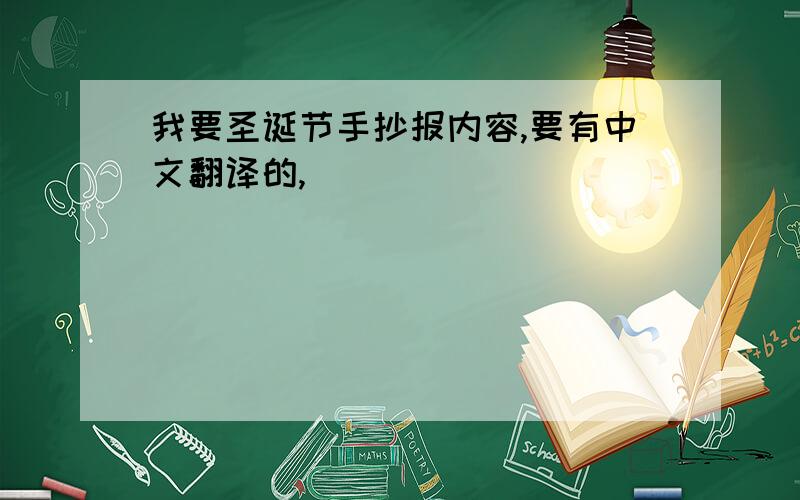我要圣诞节手抄报内容,要有中文翻译的,
来源:学生作业帮助网 编辑:作业帮 时间:2024/11/15 13:04:09

我要圣诞节手抄报内容,要有中文翻译的,
我要圣诞节手抄报内容,要有中文翻译的,
我要圣诞节手抄报内容,要有中文翻译的,
圣诞节有关的语言
【古英语】Cristes Masse
【俄语】С Рождеством
【现代英语】Christmas Day merry christmas(圣诞快乐)
【法语】le Noël
The History of Christmas
The history of Christmas dates back over 4000 years. Many of our Christmas traditions were celebrated centuries before the Christ child was born. The 12 days of Christmas, the bright fires, the yule log, the giving of gifts, carnivals(parades) with floats, carolers who sing while going from house to house, the holiday feasts, and the church processions can all be traced back to the early Mesopotamians.
Many of these traditions began with the Mesopotamian celebration of New Years. The Mesopotamians believed in many gods, and as their chief god - Marduk. Each year as winter arrived it was believed that Marduk would do battle with the monsters of chaos. To assist Marduk in his struggle the Mesopotamians held a festival for the New Year. This was Zagmuk, the New Year's festival that lasted for 12 days.
The Mesopotamian king would return to the temple of Marduk and swear his faithfulness to the god. The traditions called for the king to die at the end of the year and to return with Marduk to battle at his side.
To spare their king, the Mesopotamians used the idea of a "mock" king. A criminal was chosen and dressed in royal clothes. He was given all the respect and privileges of a real king. At the end of the celebration the "mock" king was stripped of the royal clothes and slain, sparing the life of the real king.
The Persians and the Babylonians celebrated a similar festival called the Sacaea. Part of that celebration included the exchanging of places, the slaves would become the masters and the masters were to obey.
Early Europeans believed in evil spirits, witches, ghosts and trolls. As the Winter Solstice approached, with its long cold nights and short days, many people feared the sun would not return. Special rituals and celebrations were held to welcome back the sun.
In Scandinavia during the winter months the sun would disappear for many days. After thirty-five days scouts would be sent to the mountain tops to look for the return of the sun. When the first light was seen the scouts would return with the good news. A great festival would be held, called the Yuletide, and a special feast would be served around a fire burning with the Yule log. Great bonfires would also be lit to celebrate the return of the sun. In some areas people would tie apples to branches of trees to remind themselves that spring and summer would return.
The ancient Greeks held a festival similar to that of the Zagmuk/Sacaea festivals to assist their god Kronos who would battle the god Zeus and his Titans.
The Roman's celebrated their god Saturn. Their festival was called Saturnalia which began the middle of December and ended January 1st. With cries of "Jo Saturnalia!" the celebration would include masquerades in the streets, big festive meals, visiting friends, and the exchange of good-luck gifts called Strenae (lucky fruits).
The Romans decked their halls with garlands of laurel and green trees lit with candles. Again the masters and slaves would exchange places.
"Jo Saturnalia!" was a fun and festive time for the Romans, but the Christians though it an abomination to honor the pagan god. The early Christians wanted to keep the birthday of their Christ child a solemn and religious holiday, not one of cheer and merriment as was the pagan Saturnalia.
But as Christianity spread they were alarmed by the continuing celebration of pagan customs and Saturnalia among their converts. At first the Church forbid this kind of celebration. But it was to no avail. Eventually it was decided that the celebration would be tamed and made into a celebration fit for the Christian Son of God.
Some legends claim that the Christian "Christmas" celebration was invented to compete against the pagan celebrations of December. The 25th was not only sacred to the Romans but also the Persians whose religion Mithraism was one of Christianity's main rivals at that time. The Church eventually was successful in taking the merriment, lights, and gifts from the Saturanilia festival and bringing them to the celebration of Christmas.
The exact day of the Christ child's birth has never been pinpointed. Traditions say that it has been celebrated since the year 98 AD. In 137 AD the Bishop of Rome ordered the birthday of the Christ Child celebrated as a solemn feast. In 350 AD another Bishop of Rome, Julius I, choose December 25th as the observance of Christmas.
参考:
圣诞节来历:
每年12月25日是全世界大多数基督徒纪念耶稣诞生的日子.
教会开始并无圣诞节,约在耶稣升天后百余年内才有.据说:第一个圣诞节是在公元138年,由罗马主教圣克里门倡议举行.而教会史载第一个圣诞节则在公元 336年.由于圣经未明记耶稣生于何时,故各地圣诞节日期各异.直到公元440年,才由罗马教廷定12月25日为圣诞节.公元1607年,世界各地教会领袖在伯利恒聚会,进一步予以确定,从此世界大多数的基督徒均以12月25日为圣诞节.其实哪一天并不要紧,重要的是应该知道它是为纪念救主耶稣降生.
由于圣经记载耶稣生于夜间,故传统称12月24日夜为"圣诞夜"或"平安夜".
耶稣的降生,有旧约先知预言:"必有童女怀孕生子,给他起名叫以马内利(意思为'上帝与我们同在')."(以赛亚书7章14节,圣经下同)
耶稣降生时,有天使报信:"不要惧怕,我给你们大喜的信息,是关乎万民的;因今天在大卫的城里,为你们生了救主,就是主基督.你们要看见一个婴孩,包着布,卧在马槽里,那就是记号了."(路加福音2章10-12节)
耶稣降生时,有博士朝拜,"他们看见那星就大大地欢喜.进了房子,看见小孩子和他母亲马利亚,就俯伏拜那小孩子,揭开宝盒,手拿黄金、乳香、没药为礼物献给他."(马太福音2章10-11节)
耶稣,意指"上帝拯救",因为圣经说:"世人都犯了罪,亏缺了上帝的荣耀."(罗马书3章23节)罪使人离开生命的源头,宇宙万物的主宰.罪使人失去公义、仁爱,变得自私、骄傲、贪婪、邪恶.罪破坏人与上帝、人与人之间和睦的关系,使人活在无可奈何的痛苦之中.罪使人将来要面对永远的刑罚和痛苦,"人人都有一死,死后且有审判."(希伯来书9章27节)因为上帝是圣洁、公义的!
但是,上帝又是慈爱的主,他赐给世人自己的独生子--耶稣基督,成为人的样式(就是圣诞),作我们的救赎主,他要将自己的百姓从罪恶里救出来.(马太福音 1章21节)他代替了我们的软弱,担当了我们的罪的刑罚."上帝使我们众人的罪孽都归到他身上",(以赛亚书53章6节)为我们的罪钉死在十字架上.
今天,只要你悔改自己的罪,相信他,接受他做你个人的救主,你的罪就被赦免了,你与上帝就恢复了那起初和睦的关系,你就得了永远的生命.今天你接受耶稣在你的心里,今天就是你的圣诞节,愿上帝今年赐给你一个特别的圣诞节!
各国圣诞节习俗:
法国法国中部的色日尔斯地方,每年圣诞节前后几天必降大雪,白雪皑皑,令人清新.在西方人眼里,白色圣诞是一种吉祥.在法国,马槽是最富有特色的圣诞标志,因为相传耶稣是诞生在马槽旁的.人们大唱颂赞耶稣的圣诞歌之后,必须开怀畅饮,香槟和白兰地是法国传统的圣诞美酒.
芬兰芬兰在12月圣诞节前后,漫山遍野都是怒放的紫罗兰,掩映在白色的大地上,望去一片紫红色,紫色圣诞使人心旷神怡.
英国和德国英国人和德国人一样,圣诞节喝啤酒,吃烤鹅,他们更喜欢利用圣诞节假日外出旅游.
美国美国人过圣诞节着重家庭布置,安置圣诞树,在袜子中塞满礼物,吃以火鸡为主的圣诞大菜,举行家庭舞会.
瑞士瑞士人在圣诞节前4个星期,就将4支巨型的蜡烛点燃,放在由树枝装饰成的一个环里,每周点1支,当点燃第4支后,圣诞节就到了.
丹麦丹麦人对不合意的圣诞礼物,可去商店兑换价格相似的其他商品.
澳大利亚澳大利亚是南半球的国家之一.12月底,正当西欧各国在寒风呼啸中欢度圣诞节时,澳大利亚正是热不可耐的仲夏时节.因此在澳大利亚过圣诞节,到处可以看见光着上身汗水涔涔的小伙子和穿超短裙的姑娘,与商店橱窗里精心布置的冬日雪景、挂满雪花的圣诞树和穿红棉袄的圣诞老人,构成澳大利亚特有的节日图景.这种酷暑和严冬景象的强烈对比,恐怕在西方国家是独一无二的.父母给子女最好的圣诞礼物,莫过于一副小水划.圣诞节弄潮是澳大利亚的一大特征.节日晚上,带着饮料到森林里举行“巴别居”野餐.人们用石头垒的露天灶中用枯树枝生火、上面架一块铁板,把香肠、牛肉、鲜鱼等放上去煎.吃饱喝足后,就跳起“迪斯科”或“袋鼠舞”,一直闹到深夜才结束.喝醉了的,便往草地上一躺,在如雷的鼾声中迎接圣诞老人的莅临.
波兰在波兰每年12月25日、26日举行,家家户户都要装饰圣诞树,大街小巷都有圣诞树上的装饰品出卖.节日里亲友之间相互祝贺,互赠礼品,表示友好.晚间吃饭时桌布下边要放一些草,以示耶稣的降生.晚饭很丰富,但不能吃肉.夜间12时后,全家去教堂礼拜.圣诞节期间,一般不到别人家中做客,但主人盛情邀请者例外.
保加利亚据保加利亚的历法,圣诞节是灵魂出没、妖邪猖狂的日子.因此,人们要借助火来驱妖镇邪.圣诞节前夜,家家都燃起火堆,一直燃到天亮,不得熄灭,否则会招来横祸.由男人取圣诞木点火进屋并高声念道:“圣诞节降临,牛、羊、猪、马长满圈,麦苗出满垅,人人走好运.”在屋里等候的人则齐声回答:“阿门!”
长期以来,经常唱的圣诞歌有:
《平安夜》(Silent Night)
《普世欢腾,救主下降》(Joy to the World!)
《铃儿响叮当》(Jingle Bells)
《天使歌唱在高天》(Angels We Have Heard on High)
《缅想当年时方夜半》(It Came Upon A Midnight Clear)
《美哉小城,小伯利恒》(O Little Town of Bethlehem)
《牧人闻信》(While Shepherds Wa tched Their Flocks)
《远远在马槽里》(Away in the Manger )
《荣耀天军》(Angels,from the Realms of Glory)
《听啊,天使唱高声》(Hark! the Herald Angels Sing)
《圣诞钟声》(I Heard the Bells on Christmas Day)等等,
其中以《平安夜》(Silent Night)最为有名.